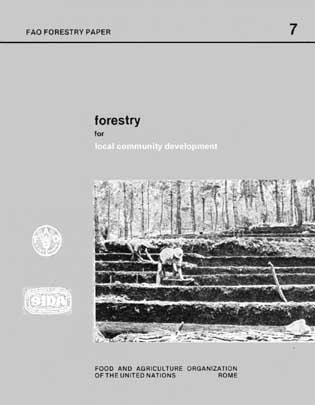Panels and sawmills
World timber encyclopaedia
A primer for charcoal-makers
Soil as a renewable resource
Modern sawmill and panel techniques, Vol. 1. Proceedings of the North American Sawmill and Panel Clinic. Miller Freeman Publications, San Francisco, 1980. 156 p. 146 drawings, photos and tables. Softcover. price: US$45.
Platen drying of veneer, a major new development in panel techniques, was described for the first time in March 1980 in Portland, Oregon, USA, at the North American Sawmill and Panel Clinic sponsored by Forest Industries magazine.
This topic takes up one of the nine chapters on panels in these newly published proceedings of the clinic. There are also 13 chapters on sawmill techniques including one on the safety-sensitive topic of noise control. The volume is a combination and continuation of two series started by Forest Industries magazine: Modern sawmill techniques, volumes 1-9 and Modern plywood techniques, volumes 17.
The sawmill section includes chapters on finger-jointing dimension :lumber for increased recovery, predictive analysis to prevent machine downtime, improved recovery in a large sawmill, saw-sizing lumber, and machine stress rating. The panel section is heavily weighted toward operational techniques, but includes chapters on the outlook for adhesives into 1984 and non-destructive testing of panel products.
The book may be ordered from: Forest Industries Book Department, 500 Howard Street, San Francisco, California 94105.
Encyclopedia of world timbers, by Julius B. Boutelje. Swedish Forest Products Research Laboratory, LiberTryck, Stockholm, 1980. 338 p.
More than 4 000 different timbers are listed :in this spacious, easy-to-use new encyclopaedia of world timbers. The first section lists the scientific names of all timbers in alphabetical order followed by the commercial or local names and then by references to the literature. In section two, all the entries are alphabetized by the commercial, or local, names followed by the scientific names and references. The third section of the book includes 377 different references, which are cited by number in the previous sections.
As many as eight or ten different local or commercial names may be given for any one species. However, the book's compiler, Julius Boutelje, notes that even this may not have been enough: "Timbers, especially those from tropical countries, may have many names which cannot be included in a book such as this. As far as possible, English standard names in the timber-producing countries have been selected."
Charcoal production using a transportable metal kiln, by A.R. Paddon and A.P. Harker. Rural Technology Guide No. 12. Tropical Products Institute, London, 1980. Softcover. 17 p.
With numerous illustrative photographs and an easy-to-read, straightforward presentation, this small book is an excellent guide for someone with little or no training in the use of the transportable metal kiln for making charcoal. In numerous developing countries, particularly in Africa, it should prove to be a most valuable resource.
Included is a description of the kiln and the tools required, followed by sections on preparation, site selection, assembly and loading, reducing the draught, charring control, cooling, unloading, sack-filling and commercial operation. There is also an appendix demonstrating an alternative method that uses lighting from the top.
Impact on soils of fast-growing species in lowland humid tropics, by E.O. Chijicke. FAO Forestry Paper No. 21. FAO, :Rome, 1980. Softcover. 111 p. including 24 p. of figures and 22 p. of tables.
Trees are a renewable resource only insofar as the soils upon which they grow are themselves renewable. This basic fact is sometimes forgotten in the rush to employ intensive :forest management, a multi-faceted type of management including such operations as the planting of fast-growing tree species.
This FAO study by E.O. Chijicke, an Andre Mayer research fellow, adds important information to the rapidly increasing pool of knowledge available on fast-growing tree species in the tropics, particularly the lowland humid tropics. One of. Chijicke's conclusions is that lightly textured soils in this environment are more severely affected by the immobilization of nutrients resulting from :intensive management and the plantation of monocultures than are heavier soils, especially those of basement complex origin. Different management procedures, including rotations of different tree species, may be needed to ensure the long-term productivity of light- and heavily textured soils.
The crux of this study is a comparison between soil conditions under natural forest with those under plantations. There are sections on background, location of study areas, methods, discussion, summary and conclusions. More than two thirds of the book is devoted to appendixes, with ample tables, figures, data, descriptions and a bibliography.
Forestry for people

publications you need

Available from the
Distribution and Sales Section
Food and Agriculture Organization of the United Nations
00100 Rome, Italy